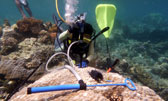




 Figure shows the schematic illustration of RADICA. Credit: Singapore-MIT Alliance for Research and Technology (SMART)
Figure shows the schematic illustration of RADICA. Credit: Singapore-MIT Alliance for Research and Technology (SMART)
● RApid DIgital Crispr Approach (RADICA) is a molecular rapid testing methodology that allows absolute quantification of viral nucleic acids in 40-60 minutes.
● RADICA is four times faster and significantly less expensive than conventional polymerase chain reaction (PCR) methods as it does not require costly equipment for precise temperature control and cycling.
● Method has been tested on SARS-CoV-2 synthetic DNA and RNA, Epstein–Barr virus in human B cells and serum, and can be easily adapted to detect other kinds of viruses.
Researchers from Critical Analytics for Manufacturing Personalized-Medicine (CAMP), an Interdisciplinary Research Group (IRG) at the Singapore-MIT Alliance for Research and Technology (SMART), MIT’s research enterprise in Singapore, have developed a new method for rapid and accurate detection of viral nucleic acids – a breakthrough that can be easily adapted to detect different DNA/RNA targets in viruses like the coronavirus.
The pandemic has highlighted the importance of rapid diagnostics and improved methods to detect viruses, especially as the world seeks to be prepared for future pandemics or the next dangerous pathogen. Particularly, the biomanufacturing industry, with the unique challenges of using cells as cell therapy products, is looking for innovations in rapid methods to detect virus contamination as part of their quality control processes and in release testing. While the reverse transcription-quantitative polymerase chain reaction (RT-qPCR) is considered a gold standard for viral detection, there are limitations and they can often produce variable results.
A more accurate version is the digital PCR method that allows absolute quantification – meaning it reveals the copy number of viruses in a sample – can allow for setting clear thresholds of virus contamination, and is not susceptible to potential fluctuations of reference gene required by standard qPCR methods. However, digital PCR demands a relatively long reaction time of around four hours. Another drawback of all current PCR-based methods is that they need expensive equipment for precise temperature control and cycling.
The new methodological development by CAMP – the RApid DIgital Crispr Approach (RADICA) – allows absolute quantification of viral nucleic acids in 40-60 minutes in an isothermal manner in a water bath, a prototypical and inexpensive laboratory equipment. The team’s research is explained in a paper titled “Digital CRISPR-based method for the rapid detection and absolute quantification of nucleic acids” published recently in the prestigious journal Biomaterials.
The RADICA method has been tested on SARS-CoV-2 synthetic DNA/RNA as well as the Epstein-Barr virus in cultured B cells and patient serum. The researchers say the method can be adapted to detect other kinds of viruses, and in other types of samples such as saliva and cell culture media. RADICA is also able to distinguish the virus from their close relatives.
“This is the first reported method of detecting nucleic acids to utilise the sensitivity of isothermal amplification and specificity of CRISPR based detection in a digital format – allowing rapid and specific amplification of DNA without the time consuming and costly need for thermal cycling,” says Dr Xiaolin Wu, Postdoctoral Associate at SMART CAMP. “RADICA offers four times faster absolute quantification compared to conventional digital PCR methods.”
The team uses extracted DNA/RNA of the sample and divides a 15 µL reaction into thousands of independent partitions. In each partition, the DNA/RNA is amplified and identified by Cas12a protein, an enzyme that can turn the target signal into a fluorescent signal. This allows absolute quantification to be achieved by counting the number of partitions that have the target DNA/RNA and are lit up.
“The last year has shown us the importance of detecting viruses quickly and accurately, and RADICA can help fill existing gaps in this area,” says National University of Singapore Professor Hanry Yu, co-corresponding author and Co-Lead Principal Investigator at SMART CAMP. “Cell therapy products have a very short shelf life and patients are usually in need of treatment urgently. Current sterility tests need around 14 days, which is too slow for clinical needs but RADICA shortens the process into hours.”
Professor Tim Lu, who is co-corresponding author, CAMP Principal Investigator and Associate Professor of Biological Engineering and Electrical Engineering and Computer Science at Massachusetts Institute of Technology, said the team’s method is faster, cheaper and more efficient than what is used today and its digital format makes it more tolerant to contamination or inhibitors that may be present in biological samples – often the case with cell therapy products. Professor Lu adds that on top of detecting the presence of a target virus, RADICA also identifies how many viruses there are in the sample which can help doctors and researchers in deciding the course of treatment, as well as production and inventory management of cell therapy products.
While the researchers at CAMP developed RADICA for monitoring cell therapy manufacturing processes and biosafety release testing of cell therapy products, Dr Wu says the method can also be used to detect DNA/RNA targets of different viruses and adapted to devices commonly found in hospitals and service laboratories – providing a potential new way to tackle pandemics.
The research is carried out by SMART and supported by the National Research Foundation (NRF) Singapore under its Campus for Research Excellence And Technological Enterprise (CREATE) programme.